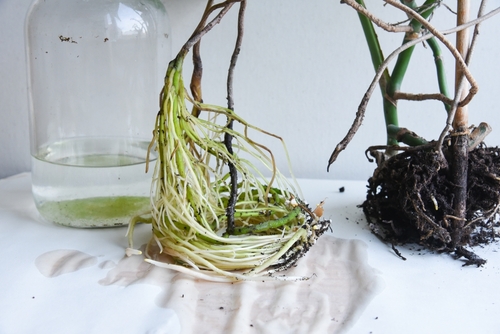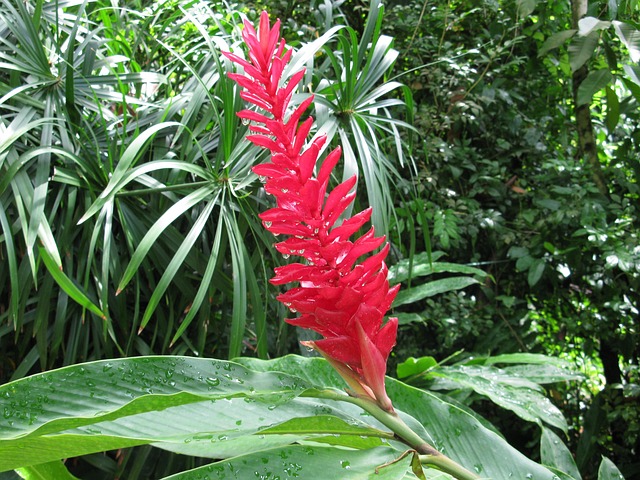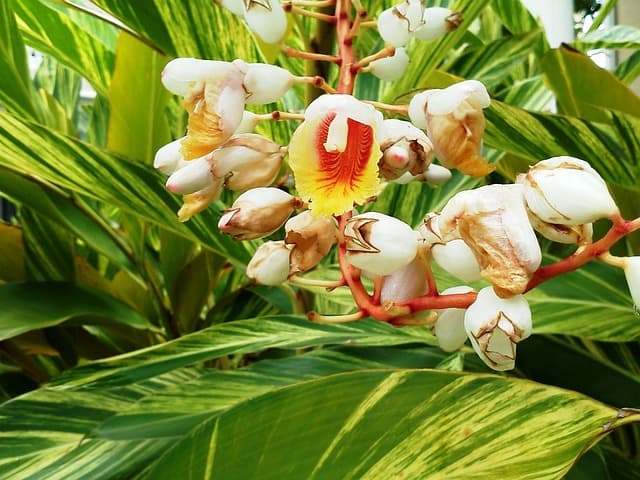Ginger plants are a popular choice for gardeners who want to grow their own spices. However, it can be frustrating to see the leaves of your ginger plant turning yellow.
This can be a sign of a variety of issues, from overwatering to diseases. Understanding the potential causes of yellowing in ginger plants is essential to keep your plant healthy and thriving.
There are several reasons why ginger plant leaves may turn yellow. Overwatering is a common cause, as ginger plants require moist soil but cannot tolerate waterlogged conditions.
Underwatering can also lead to yellowing leaves. Diseases such as Fusarium Yellow and Rhizome Rot can also cause yellowing, as can pests like White Grubs and Shoot Borer. Proper care and treatment can help prevent and address these issues, but it’s important to identify the underlying cause of the yellowing first.
Key Takeaways
- Ginger plant leaves turning yellow can be a sign of various issues, including overwatering, diseases, and pests.
- Proper care and treatment can help prevent and address these issues, but identifying the underlying cause is essential.
- Understanding the potential causes of yellowing in ginger plants is crucial to keep your plant healthy and thriving.
Check out these other top posts:
- Philodendron Leaves Turning Yellow with Brown Spots
- Why Is My Fiddle Leaf Turning Yellow?
- Why Is My Creeping Charlie Turning Yellow?
Understanding Ginger Plant Yellowing

Signs of Yellowing
Yellowing of ginger plant leaves is a common problem that can be caused by a variety of factors. One of the most common reasons for yellowing of ginger plant leaves is a lack of nutrients, particularly nitrogen, phosphorus, and potassium. This can be resolved by adding fertilizer to the soil.
Another reason for yellowing of ginger plant leaves is overwatering or underwatering. Overwatering can lead to root rot, which can cause the leaves to turn yellow and brown. Underwatering can lead to dry, yellow leaves. It is important to maintain a consistent watering schedule and ensure proper drainage.
Ginger plant yellowing can also be a sign of a fungal infection. Fusarium wilt or fusarium yellow is a fungal disease that can cause yellowing of the leaves, which eventually fall off, and the plant wilts and dies. Dry rot, rhizome rot, and white grubs can also cause yellowing of ginger plant leaves.
Process of Yellowing
The process of yellowing in ginger plants typically begins with the older leaves turning yellow first. As the problem progresses, the yellowing may spread to the younger leaves. Eventually, the leaves may turn brown and fall off.
It is important to identify the underlying cause of the yellowing in order to address the problem effectively. If the cause is a lack of nutrients, adding fertilizer can help. If the cause is overwatering or underwatering, adjusting the watering schedule can help. If the cause is a fungal infection, treatment with a fungicide may be necessary.
Why Is My Ginger Plant Turning Yellow – 4 Common Problems
Ginger plants are hardy plants that can grow in a wide range of conditions. However, gardeners may notice that their ginger plants are turning yellow, which can be a sign of stress or disease.
There are several reasons why ginger plants may turn yellow, including water and moisture issues, soil and nutrition problems, light and temperature factors, and pests and disease.
1. Water and Moisture Issues
Overwatering or underwatering can cause yellowing in ginger plants. If the soil is too wet, the roots may rot, which can lead to yellowing of the lower leaves. On the other hand, if the soil is too dry, the leaves may curl and turn yellow.
Proper drainage is essential for ginger plants, and gardeners should ensure that the soil is moist but not waterlogged. Mist the leaves and use a humidifier to create a humid environment.
2. Soil and Nutrition Problems

Ginger plants require adequate nutrition to grow and thrive. A lack of essential nutrients such as nitrogen, phosphorus, or potassium can cause yellowing leaves.
Gardeners should fertilize their ginger plants regularly with compost or a balanced fertilizer. Soil pH should be between 5.5 and 6.5, and gardeners should ensure that there are enough drainage holes in the pot or raised bed.
3. Light and Temperature Factors
Ginger plants prefer adequate light and warm temperatures between 68-77°F (20-25°C) and high humidity levels. Low temperatures or sudden changes in temperature can cause the leaves to turn yellow.
Ginger plants also require shade during the hottest part of the day and adequate light to grow. If grown indoors, place the ginger plant near a sunny window.
4. Pests and Disease
Yellowing leaves can also be a sign of pests or disease. Spider mites, white grubs, and shoot borers can cause yellowing and curling of the leaves.
Pathogens such as Fusarium, bacterial wilt, and soft rot can also cause yellowing and rotting of the rhizomes. Gardeners should use neem oil or other organic pesticides to control pests and ensure that the growing conditions are optimal to prevent disease.
Diseases Affecting Ginger Plants
Ginger plants are susceptible to various diseases that can cause yellowing of the leaves. In this section, we will discuss some of the common diseases affecting ginger plants.
1. Bacterial Wilt
Bacterial wilt is a serious disease that affects ginger plants. It is caused by the bacterium Ralstonia solanacearum and can lead to the death of the plant. The disease is characterized by wilting of the leaves and yellowing of the foliage.
The bacteria can survive in the soil for several years and can infect the plant through the roots. Once infected, the plant cannot be cured, and the only solution is to remove and destroy the infected plant.
2. Fusarium Yellow
Fusarium yellow is caused by the fungus Fusarium oxysporum. The disease affects the roots and rhizomes of the ginger plant, causing them to rot. The leaves of the plant turn yellow and eventually die.
The fungus can survive in the soil for several years, making it difficult to control. The use of vegetable fungicides such as benomyl and zineb can help control the disease.
3. Pythium Rot

Pythium rot is caused by the fungus Phytophthora sojae. The disease affects the roots and rhizomes of the ginger plant, causing them to rot. The leaves of the plant turn yellow and eventually die.
The fungus can survive in the soil for several years, making it difficult to control. The use of vegetable fungicides such as benomyl and zineb can help control the disease.
4. Dry Rot
Dry rot is caused by the fungus Rhizopus stolonifer. The disease affects the rhizomes of the ginger plant, causing them to rot. The leaves of the plant turn yellow and eventually die.
The fungus can survive in the soil for several years, making it difficult to control. The use of vegetable fungicides such as benomyl and zineb can help control the disease.
Treatment and Prevention
If your ginger plant is turning yellow, there are several treatment and prevention methods you can use to help it recover and prevent future issues. Here are some tips to keep in mind:
1. Appropriate Watering
Overwatering can cause ginger plant leaves to turn yellow, so it’s important to ensure the plant is receiving appropriate watering. Ginger plants require moist soil, but they do not tolerate waterlogged conditions.
One way to check if the soil is too wet is to insert your forefinger into the plant’s pot. If the soil is dry, water it, and give it time to recover. If it is very wet, put it out in the sun to evaporate the excess water. Ensure that the pot has proper drainage to prevent waterlogging.
2. Proper Fertilization
A balanced fertilizer with equal parts nitrogen, phosphorus, and potassium is ideal for ginger plants. You can also add organic matter to the soil to improve its nutrient content. Proper fertilization can help keep the plant healthy and prevent yellowing of leaves.
3. Disease Control
Soft rot and green wilt are two common diseases that can cause ginger plant leaves to turn yellow. Fungicides like benomyl and zineb can help control these diseases.
Vegetable fungicides can also be used to control fungal diseases. If the plant is severely infected, it may need to be removed to prevent the spread of disease to other plants.
4. Pest Control
White grubs are a common pest that can cause ginger plant leaves to turn yellow. Neem oil can be used as a natural insecticide to control white grubs. Treated seeds can also be used to prevent pest infestations. If the plant is severely infested, it may need to be removed to prevent the spread of pests to other plants.
Remember that prevention is key to keeping your ginger plant healthy. Ensure that the plant is in a humid environment, either by placing it in a humidifier or on a windowsill with proper sunlight.
Proper drainage is also important to prevent waterlogging. If the plant goes into dormancy during the winter months, reduce watering and fertilization to prevent browning of leaves. By following these tips, you can help keep your ginger plant healthy and prevent yellowing of leaves.
Proper Ginger Plant Care

Growing ginger plants requires proper care to ensure optimal growth and prevent yellowing leaves. Here are some tips for proper ginger plant care:
1. Proper Watering
Ginger plants require consistent moisture to thrive, but overwatering can lead to root rot. Make sure to water the plant deeply but infrequently, allowing the soil to dry out slightly between waterings. Adequate drainage is also crucial to prevent water from accumulating around the roots.
2. Adequate Light
Ginger plants require bright, indirect sunlight to grow properly. They can tolerate some shade, but lack of light can cause stunted growth and yellowing leaves. Consider placing the plant near a window that receives plenty of sunlight, or using grow lights if necessary.
3. Optimal Soil Conditions
Ginger plants require well-draining soil that is rich in organic matter. Consider adding compost or other organic material to the soil to improve its texture and nutrient content. A pH level between 6.0 and 7.0 is ideal for ginger plants.
4. Ideal Temperature and Humidity
Ginger plants thrive in warm, humid environments. They prefer temperatures between 68°F and 77°F, and humidity levels between 50% and 70%. Consider using a humidifier to maintain optimal humidity levels, especially during winter months when indoor heating can dry out the air.
Proper growing conditions are crucial for ginger plants to remain healthy and avoid diseases such as rhizome rot and fusarium wilt.
Gardeners should also fertilize the plants regularly with a balanced fertilizer that contains nitrogen, phosphorus, and potassium. Consider using neem oil or other natural remedies to combat pests and diseases.
Frequently Asked Questions

What causes yellow spots on ginger leaves?
Yellow spots on ginger leaves can be caused by a variety of factors. One common cause is fungal infection, which can be identified by the presence of brown or black spots on the leaves.
Another possible cause is bacterial wilt, which can cause yellowing and wilting of the leaves. Nutrient deficiencies or excesses can also result in yellow spots on the leaves.
How do I treat fungus on my ginger plant?
Treating fungus on a ginger plant typically involves removing the infected leaves and spraying the plant with a fungicide. It is important to follow the instructions on the fungicide carefully and to continue treating the plant until the fungus is completely eradicated.
Why are the leaves on my ginger lily turning yellow?
Yellowing leaves on a ginger lily can be caused by a variety of factors, including overwatering, underwatering, nutrient deficiencies, or pest infestations. It is important to identify the underlying cause of the yellowing leaves in order to properly treat the plant.
What are the best growing conditions for ginger root?
Ginger root prefers warm temperatures between 68-77°F (20-25°C) and high humidity levels. It also requires well-draining soil and regular watering. It is important to avoid overwatering or underwatering the plant, as well as exposing it to extreme temperatures or direct sunlight.
How do I revive a struggling ginger plant?
To revive a struggling ginger plant, it is important to identify the underlying issue and address it accordingly. This may involve adjusting the plant’s growing conditions, such as providing more or less water, adjusting the lighting, or treating a pest infestation.
How often should I water my ginger plant?
Ginger plants require regular watering, but it is important to avoid overwatering the plant, as this can lead to root rot. It is recommended to water the plant once or twice a week, depending on the humidity levels and temperature in the growing environment.
It is also important to ensure that the soil is well-draining to prevent water from accumulating around the roots.

Hey, I’m Lisa and I’ve been an avid gardener for over 30 years. I love writing, talking and living in the garden! Feel free to connect with me on my socials below


